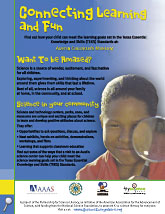
An electronic newsletter for the science education community
Connecting Learning and Fun
New brochures link family science activities to state
learning goals
Observing plants and animals at a nearby park. Visiting a local zoo or aquarium. Experiencing hands-on exhibits at a science and technology center. All of these activities can help families support children in exploring the world around them and developing positive attitudes about science. But community science activities can also help parents support what their children are learning in the classroom. A new set of brochures from AAAS’s Partnership for Science Literacy shows how activities at local science centers, parks, zoos, and museums relate to the learning goals that states expect children to achieve.

The English/Spanish brochures build on the Partnership’s previous outreach to parents in five key partner sites—Austin, TX; Chicago, IL; Lehigh Valley, PA; Los Angeles, CA; and Tampa, FL. With a “Science. It’s Everywhere” theme, the Partnership has been reaching out to families about the importance of science, mathematics, and technology literacy for all students. Public service announcements in English and Spanish, annual community science events at the partner sites, Family Guide to Science booklets for 26 communities around the country, and a Web site at www.ScienceEverywhere.org have all aimed to engage parents in the science learning opportunities in their communities and everyday lives.
Reinforcing Learning Goals
The new brochures extend parents’ familiarity with
community science resources to their awareness of science learning
goals set by their state’s department of education. As learning
goals become more central to how schools teach and assess students
in science, families need to become better informed about what their
children are expected to learn and how activities outside of school
can support what takes place in the classroom.
Each brochure explains how local exhibits and activities can help children learn particular state standards and gives parents the Web site address for learning more about their state’s science standards. Highlighted activities range from encounters with nature to explorations of force and motion:
-
“Exploration Station” at the Austin Children’s Museum: Visitors to the “Exploration Station” gallery participate in facilitated, hands-on activities with themes that emphasize science inquiry processes, problem solving, or creative thinking. The exhibit aligns with many science Texas Essential Knowledge and Skills (TEKS) Standards for grades pre-K through 4, including 2.2.2A-F and 2.2.4.A-B, which state in part: “The student uses age-appropriate tools and models to verify that organisms and objects and parts of organisms and objects can be observed, described, and measured.”
-
“Look Up, Look Down!”in the Chicago Park District: Chicago families are encouraged to “Take a walk through your park and look for animals that spend most of their time in the tops of trees or flying.” The brochure suggests a series of questions parents can ask their child to guide their observations and links the activity to Illinois State Goal 12B: “Know and apply concepts that describe how living things interact with each other and their environment.”
-
“Work Bench” and “Science Playground” at the Da Vinci Discovery Center: In Pennsylvania’s Lehigh Valley, the Da Vinci Discovery Center offers exhibit areas that engage students with the use of levers, pulleys, gears, and interactive scales. These exhibits help reinforce two Pennsylvania science standards for students in grades K–8: “Observe and describe different types of force and motion”(Standard 3.4.4C) and “Identify and explain the principles of force and motion” (Standard 3.4.7C).
-
“African Mammal Hall” at the Natural History Museum of Los Angeles County: At the “African Mammal Hall,” children can identify familiar animals like giraffes, hippos, and lions, and discover creatures they may have never seen before, from a bongo to an oryx. The Los Angeles brochure suggests questions appropriate for kindergarteners and for second graders and explains that the exhibit demonstrates two California Life Sciences standards: “Kindergarteners know how to identify major structures of common animals” (Standard 2c) and “Second graders know that organisms reproduce offspring of their own kind and that the offspring resemble their parents and one another” (Standard 2a).
-
“No Bones Zone” at the Florida Aquarium: In Tampa, this hands-on exhibit allows families to touch animals that have no bones for a skeletal structure—sea stars, crabs, urchins, mollusks, and other invertebrates. Questions like “What do the animals have in common?” and “What differences do you see between the animals in the tank?” help support Florida’s Sunshine State Standard F: “Students should describe patterns of structure and function in living things; students should know that living things are different but share similar structures.”
The partner sites distributed the brochures at their spring 2005 family science events and continue to use them in educational programming for families. For more details about the Partnership and its resources for parents across the country, visit www.ScienceEverywhere.org.
# # #
Funded by the National Science Foundation, AAAS’s Project 2061 and Education and Human Resources Directorate established the Partnership for Science Literacy to build support for science literacy among parents, especially in Hispanic and African American communities. The Partnership brings AAAS together with informal science education institutions across the country and with groups like TryScience.org.
For more information about the Partnership and its collaborations with informal science education institutions, please contact:
Communications Director, AAAS Project 2061: Mary
Koppal, (202) 326-6643
Senior Project Director, AAAS Education and Human Resources
Programs: Judy Kass, (202) 326-6667
Principal Investigator: Dr.
Jo Ellen Roseman, (202) 326-6666



